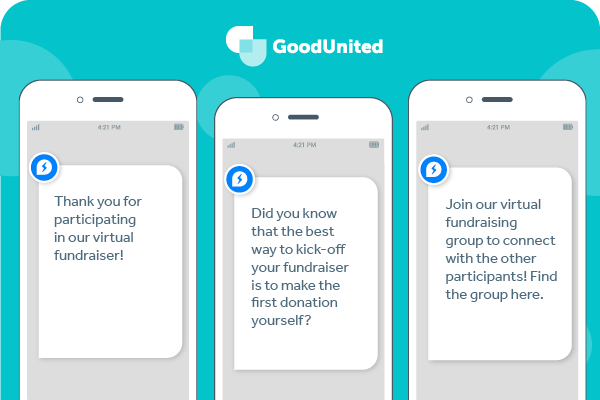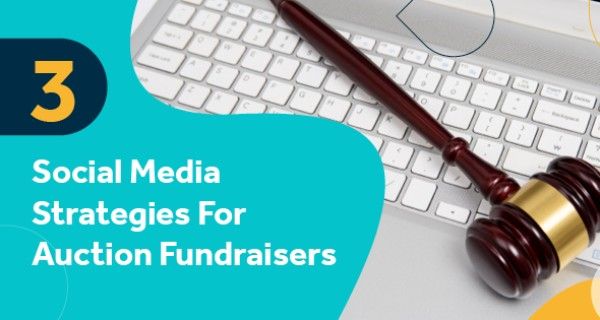As we head further into 2021, it’s clear that virtual and hybrid events are here to stay for the foreseeable future. This is both to promote safe practices during the pandemic and because these opportunities present a plethora of benefits. Specifically in the case of our focus for this piece— virtual auctions— virtual and hybrid events allow for expanded reach, extended bidding times, and the ability to generate excitement leading up to the event itself.
But, there’s no denying that many organizations rushed into moving their auctions to the digital sphere in 2020, and that quick transition left much to be desired in some cases. As you prepare for a new year of virtual auctions, revisit your strategies to plan events that both raise revenue and continue growing relationships with supporters after the fact.
In this guide, we’re going to discuss one aspect of your auction strategy— social media— and how you can use it to better engage donors before, during, and after your auction event. At GoodUnited, we specialize in the intersection of social media fundraising, researching and assisting nonprofits with Facebook fundraising. We’ve seen firsthand how focusing on understanding, inspiring, and cultivating relationships with supporters can revolutionize a nonprofit’s efforts on social media platforms.
We’re going to walk through this methodology as it pertains to your social media strategy for your next auction fundraiser. This guide will cover the following tips:
- Understand your audience to promote your auction fundraiser.
- Inspire social supporters to engage with your auction using Facebook groups.
- Cultivate relationships with supporters after the auction is complete.
With these tips, you’ll increase revenue for your next fundraiser and build sustaining relationships with supporters. Let’s dive in.
Understand your audience to promote your auction fundraiser.
The traditional guidance around using social media for auctions is that you should use social platforms to promote upcoming events. We’re not going to argue that you shouldn’t do that— you definitely should— but we are going to suggest that there is a more effective way to do so than the usual approach taken by organizations.
Think about how you’ve used social media to promote your auctions in the past. Maybe you’ve created a PDF or image “flyer” that includes all of the pertinent information— the event date, how to register to attend, a brief overview of items available, and an overview of why a donor should support your mission through this event— and shared that on all of your social profiles. You likely included a catchy call-to-action inviting supporters to register for the event and encouraged them to ask questions if necessary.
That’s not a bad strategy! But, by focusing on understanding your social supporters, what they respond to and what they’re interested in, you can drastically improve your approach and increase engagement with your posts leading up to the auction event.
Take a deep dive into the social engagement data in your nonprofit CRM and perhaps even poll your social supporters to understand their engagement preferences. Then, use that information to make adjustments to certain aspects of your strategy, including:
When you post: While posting consistently is a strong digital marketing strategy, when you post can be just as important. Often, the period between 12 p.m. and 3 p.m. is the most effective time to share content, but consider experimenting with this— for instance, posting similar content at two different times— to see which is the most impactful time for your social audience.
What you post: Beyond posting logistical information about your event, such as the date, time, and how to engage with it, we recommend posting specific information about your mission, how the auction will impact it, and the items that will be available to bid on. When doing so, use evocative images and videos and create detailed and appealing descriptions of your key auction items.
Where you post: Examine data in your CRM to discover which social media platforms your supporters are most active on, whether Instagram, Twitter, Facebook, or a newer platform like TikTok. Focus your efforts on the networks that your supporters are most active on and tailor your posts accordingly— for example, Twitter is great for quick, pithy updates while Facebook can better host longer-form storytelling content.
What we’ve discovered while researching birthday fundraisers on Facebook is that people share nonprofit information on Facebook to express their support of the mission and nonprofit itself— in fact, 84% of social media users report highlighting causes that are meaningful to them as their main motivation to share.
Draw on that motivation by creating evocative copy and visuals then posting that information when and where your audience is most likely to encounter it. By doing this, you can increase your chances of supporters spreading the word about your auction on social media.
Inspire social supporters to engage with your auction using Facebook groups.
For the remainder of this guide, we’re going to focus on one social network: Facebook. This is not only because 58% of American adults are Facebook users (with that number jumping to 87% when you consider the 18 to 29 age range), but also because Facebook has the most expansive functionality of the major social networking platforms when it comes to fundraising, livestreaming, developing groups, and more.
Let’s focus on Facebook groups and how those can be used to inspire social supporters to engage with your auction. To start this process, you’d make a Facebook group pertaining exclusively to your auction event. Cross promote this group, sharing news of it on Facebook, on other social media platforms, in physical outreach, and within auction information on your website to increase the likelihood that auction attendees join.
Then, prior to the event, consider the following ways to use the group to inspire auction engagement:
Share an auction catalog. Each day, post a new item that will be included in your auction. Remember, images are worth a thousand words, so make sure to include a visual element whether a photo or video when sharing the new items. This allows supporters to peruse items and craft their strategy for obtaining winning items that catch their eye— overall, generating excitement for your event.
Create community for attendees. Share evocative stories about your mission and work, testimonials from constituents and volunteers, and even discussion questions. Create a group conversation that encourages attendees to connect with your nonprofit and with one another, moderating the discussions to ensure they stay on topic. This shows attendees that while your auction is a single event, the impact of the donations raised is much larger than a one-time experience. Plus, the community created through the event has the power to make an even greater difference if they band together to continue supporting the mission.
Share educational materials about your auction. From within the group, direct attendees to your virtual auction software solution where they can engage with the event itself. For those that haven’t attended a virtual auction before, you can share educational information about how to get involved— whether how to register, make bids, track bids, purchase for-sale items, or even make additional paddle-raise donations. If you’re working with a solution such as Auctria, you’ll be able to send users to a dedicated virtual auction website where they can bid through a streamlined process and pay for won items with ease.
Last but certainly not least, groups can be used as a conduit to get users to connect with your nonprofit through Facebook Messenger. With Messenger and one-on-one conversational messaging, which we’ll discuss further in the next section, users can stay in the loop with your nonprofit and continue their engagement long after your auction itself ends.
Make a post within your auction group inviting users to connect with your nonprofit through Messenger, and then use the tips in the next section to grow long-lasting relationships.
Cultivate relationships with supporters after the auction is complete.
A key strategy to boost revenue after your charity auction is to continue engaging with your supporters. On social media, one of the best ways to do this is by conversing one-on-one with auction donors and attendees through Facebook Messenger.
Check out the image below, pulled from GoodUnited’s guide to virtual fundraising, for a visual of what this could look like:

One-on-one conversational messaging empowers you to build personal connections with each individual supporter of your nonprofit, converting them from one-time supporters to lifelong philanthropists.
While Messenger is a great platform to express gratitude to supporters and show them that you appreciate their individual efforts, you can also use it to send a variety of communications. When sending one-on-one messages back and forth with individual supporters, you can:
Share opportunities to give more.
According to the matching gift experts at 360MatchPro, 93% of companies that offer matching gift programs have a minimum match requirement of less than or equal to $50. For donors who work at companies offering matching gift programs, there’s a good chance that donations made through your auction are match-eligible.
With one-on-one messaging, educate donors about matching gifts, volunteer opportunities, Facebook fundraisers, and recurring giving to provide additional opportunities to give back to your mission.
Learn more about your social supporters.
Within Messenger, you can share surveys and ask supporters one-off questions to obtain basic information (such as contact details) and understand each individual better. For example, you can ask:
- Why did you choose to support this auction?
- What is most compelling about our mission?
- How would you like to engage with our nonprofit going forward?
- What can we do to make supporting our cause a more positive experience?
You can then use this information to improve your virtual and social fundraising opportunities going forward. And, supporters will see that you value their individual opinion and be encouraged to continue engaging with you.
Stay in touch with social supporters year-round.
Beyond communicating in the days immediately after your fundraiser ends, use Facebook Messenger to stay in touch with supporters throughout the year. For example, you can:
- Send an update on how much was raised through your auction and how those funds are being used.
- Share advocacy efforts throughout the year to spread the word.
- Provide updates on your organization and any upcoming opportunities to give back.
- Send a heartfelt happy birthday note and invite the user to donate their birthday to fundraise for your cause through a Facebook fundraiser.
The list goes on! The idea is that you can have a running conversation with individual supporters and continue growing those relationships throughout the year, after your auction event has ended.
To wrap up, social media is a powerful tool to spread the word about your auction fundraiser. However, that’s not all!
Use your social media platforms to understand, inspire, and grow relationships with supporters to truly elevate your social strategy for your next auction. With these tips, you’ll be off to a great start!
Special thanks to the author, Nick Black at GoodUnited for sharing his advice. Nick is the Founder and CEO of GoodUnited, a venture backed Software as a Service (SaaS) startup that helps nonprofits like Wounded Warrior Project, American Cancer Society, World Wildlife Fund create 1:1 relationships with their donors through the combination of data science and human judgement delivered in conversational messaging platforms.
